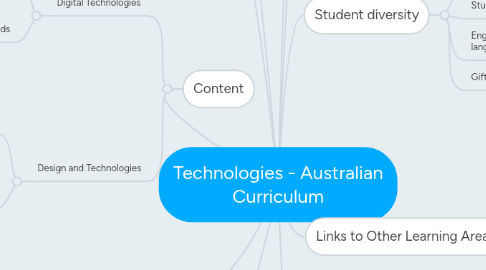
1. Content
1.1. Digital Technologies
1.1.1. Students use computational thinking and information systems to define, design and implement digital solutions
1.1.2. Strands
1.1.2.1. Knowledge and Understanding
1.1.2.1.1. Understanding the components of digital systems and how data are represented and structured symbolically
1.1.2.2. Processes and Production Skills
1.1.2.2.1. Collecting, managing and analysing data. Defining, designing, implementing, evaluating, collaborating and managing digital solutions
1.2. Design and Technologies
1.2.1. Students use design thinking and technologies to generate and produce designed solutions for specific needs and opportunities
1.2.2. Strands
1.2.2.1. Knowledge and Understanding
1.2.2.1.1. Understanding the use, development and impact of technologies in peoples lives and technologies and design across a range of technologies contexts
1.2.2.2. Processes and Production Skills
1.2.2.2.1. Creating design solutions by investigating, generating, producing, evaluating, collaborating and managing.
2. Cross-curriculum Priorities
2.1. Aboriginal and Torres Strait Islander histories and cultures
2.2. Asia and Australia's engagement with Asia
2.3. Sustainability
3. Key Ideas
3.1. Creating preferred futures
3.2. Project management
3.3. Thinking in technologies
3.3.1. Systems thinking
3.3.2. Design thinking
3.3.3. Computational thinking
4. Curriculum structure
4.1. Band descriptions
4.1.1. Provide information about the learning contexts that apply to the content descriptions and achievement standards in each band
4.2. Bands
4.2.1. Foundation to Year 2
4.2.2. Years 3 and 4
4.2.3. Years 5 and 6
4.2.4. Years 7 and 8
4.2.5. Years 9 and 10
4.3. Achievement Standard
4.3.1. Indicate the quality of learning that students should typically demonstrate by a particular point in their schooling
4.4. Content descriptions
4.4.1. Describe the knowledge, understanding and skills that are expected be be taught and learn
4.5. Content elaborations
4.5.1. Provided for each content description to illustrate content
4.5.2. Are intended to help teachers in developing an understanding of the content
5. Resources
5.1. Energy Efficient House
5.1.1. http://dtm4260.edublogs.org/2015/08/07/energy-efficient-house/
5.2. Milk Cycle
5.2.1. http://dtm4260.edublogs.org/2015/08/07/milk-cycle/
